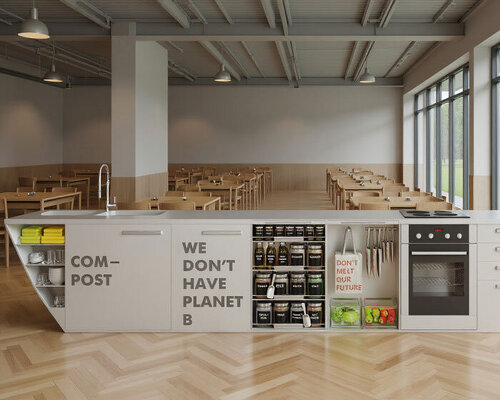Ivana Steiner Proposes Circular Urban Model for Vienna
Zero Waste Kitchen City, a research and urban design proposal by Ivana Steiner, envisions a self-sustaining urban ecosystem grounded in circular design principles. Expanding upon the architect’s earlier Zero Waste Kitchen concept, the project proposes a transformation of Vienna’s urban fabric by integrating food production, waste management, mobility, and energy systems into a closed-loop infrastructure. The initiative builds on the Zero Waste Kitchen prototype, constructed from recycled stainless steel and glass, materials selected for durability, visibility, and recyclability. These choices reflect a commitment to long-term material cycles. In Zero Waste Kitchen City, this principle extends from a single kitchen to an entire urban system, where architecture, infrastructure, and daily life operate within interconnected ecological and social loops.
Reimagining Vienna as a layered and productive environment, the proposal introduces new forms of urban land use. Rooftops become sites for cultivation, parks adopt agricultural functions, and streets shift toward markets and social spaces. Transport and technical systems are relocated underground to reduce heavy traffic, allowing the ground level to prioritize public life. Through proximity, adaptability, and material reuse, the model aims to reduce both waste and energy consumption. Roofscapes form a central element of the ecological framework. Traditional pitched roofs are converted into flat, accessible surfaces that accommodate vegetable gardens, orchards, and grazing areas, contributing to local food production and mitigating urban heat. Each rooftop operates as a micro-ecosystem, integrating soil, compost, and water management systems that support biodiversity and cyclical resource flows. Material strategy further reinforces the project’s temporal and ecological approach. Wood, representing organic change and eventual return to the soil, contrasts with recycled steel, which offers structural stability and weather resistance. Combined, the materials establish an architectural language that balances longevity with renewal.
Zero Waste Kitchen in a school space | all images courtesy of Ivana Steiner
Shared Kitchens Anchor a Cooperative Urban Framework
Alongside food production, the proposal introduces habitats for insects and pollinators through soil design, composting, bloom corridors, and water points. These interventions are functional components of a broader ecological network, contributing to a resilient and self-sustaining urban environment. Aligned with Vienna’s cooperative culture, Zero Waste Kitchen City, conceived by designer Ivana Steiner, incorporates shared spaces such as community kitchens and open markets within residential and institutional buildings. These areas support collective cooking, exchange, and education. Emphasizing short supply chains and regional production, the model reduces transport distances and carbon emissions while strengthening neighborhood connections.
Mobility and infrastructure are reorganized to enhance public space. By relocating vehicular systems below ground, the street level becomes a social and ecological platform. Markets, depots, and pedestrian routes replace car lanes, while quiet logistics systems, including cargo bikes and night-time distribution, ensure daily operations proceed with minimal disturbance. Climate adaptation is addressed through strategies such as roof greening and water retention. Cultivated rooftops function as sponges that absorb rainwater, regulate temperature, and support evapotranspiration, contributing to improved microclimates and increased resilience to heatwaves and heavy rainfall.
Zero Waste Kitchen in a restaurant
a Regenerative model of Production, Reuse, and Cooperation
The model operates on an ‘economy of proximity,’ where reduced packaging, local production, and shorter distribution networks lead to lower energy use and operational costs. It also supports emerging forms of urban employment in food production, recycling, and maintenance, complemented by educational programs focused on sustainable living and design. Zero Waste Kitchen City also foregrounds seasonality and cyclical consumption. It imagines a city aligned with natural rhythms, planting in spring, harvesting in autumn, preserving in winter, and celebrating in summer, shifting urban life from linear consumption to cyclical renewal.
At the academic scale, the Zero Waste Kitchen functions as a research module bridging architecture, ecology, and social science. As a public installation, it becomes a participatory space for cooking, learning, and collective action. The city-scale proposal extends this framework, creating opportunities for collaboration among designers, researchers, and policymakers. Ultimately, Zero Waste Kitchen City envisions a metropolitan model in which environmental cycles are embedded in everyday life. It positions architecture as a driver of ecological transition, transforming the kitchen, the building, and the city into a continuous system of production, reuse, and cooperation. The project reframes urban living as participation in a regenerative loop uniting material, social, and ecological sustainability.
Zero Waste Kitchen in a workspace
urban rooftop greening versus the current status in Vienna
a large agricultural field on Vienna’s roofs
Vienna’s green roofs with trees
cows on green roofs
roofs as self-regulating ecosystems
vegetable beds, orchards, and grazing zones on roofscapes
sustainably-run street markets to shop Zero Waste
Zero Waste Kitchen at a small street market
Zero Waste Kitchen in 400 years
traffic is relocated beneath the city
project info:
name: Zero Waste Kitchen City
designer: Ivana Steiner | @ivanasteiner_design
location: Vienna, Austria
designboom has received this project from our DIY submissions feature, where we welcome our readers to submit their own work for publication. see more project submissions from our readers here.
edited by: christina vergopoulou | designboom
The post zero waste kitchen city expands domestic prototype into self-sustaining urban ecosystem appeared first on designboom | architecture & design magazine.

